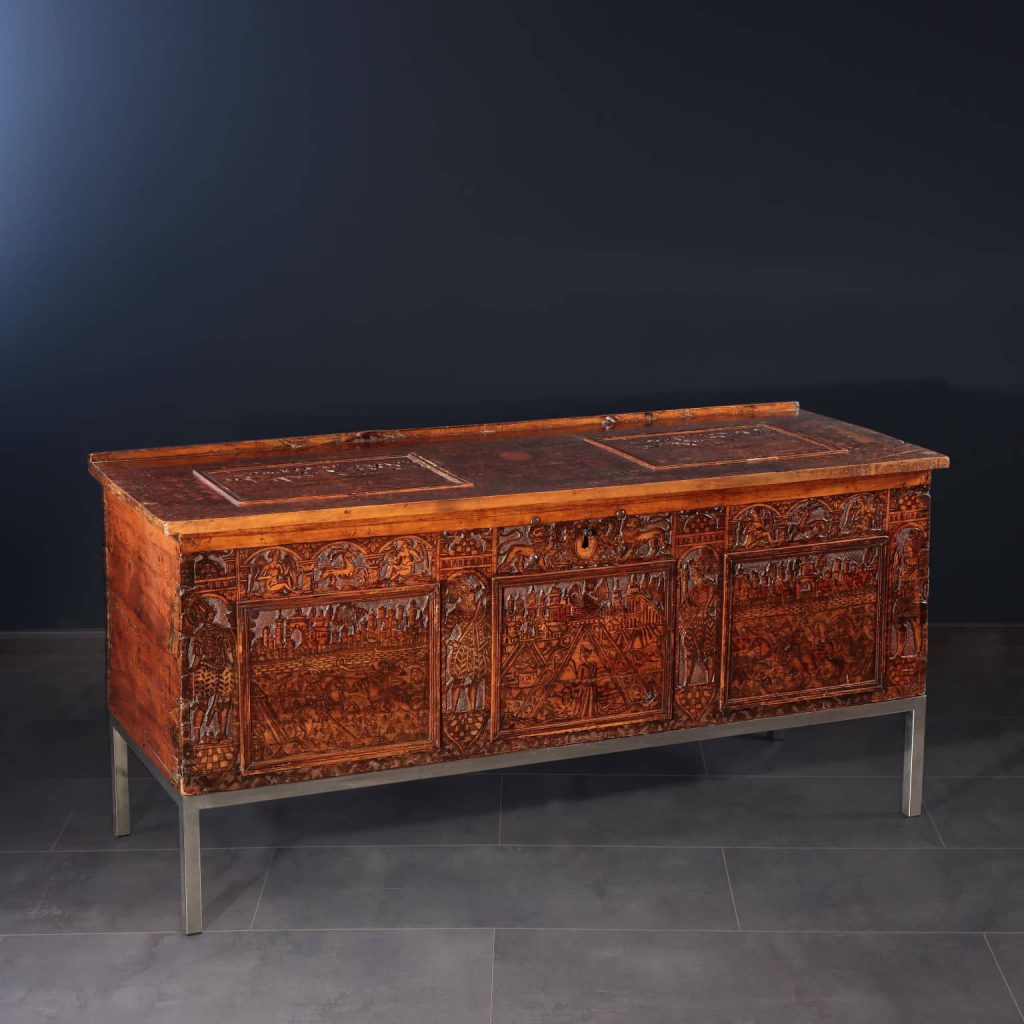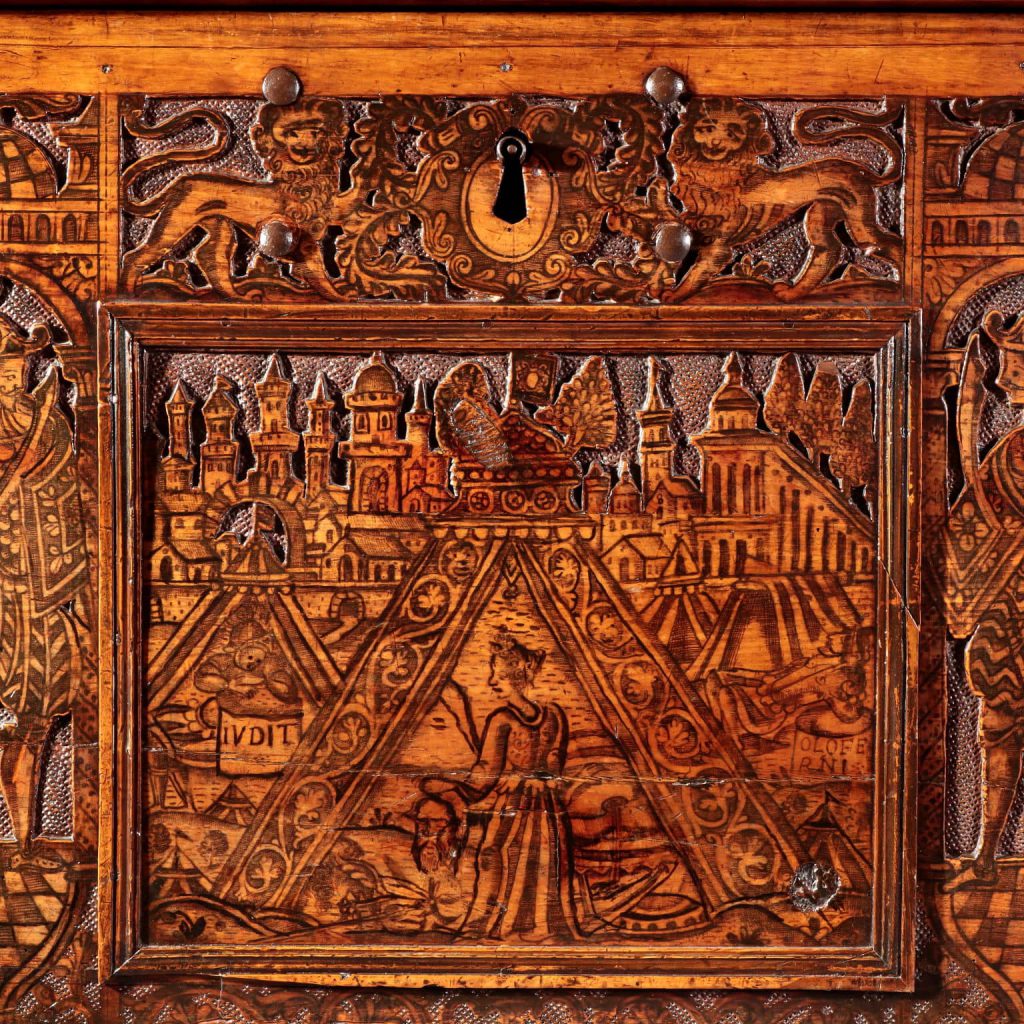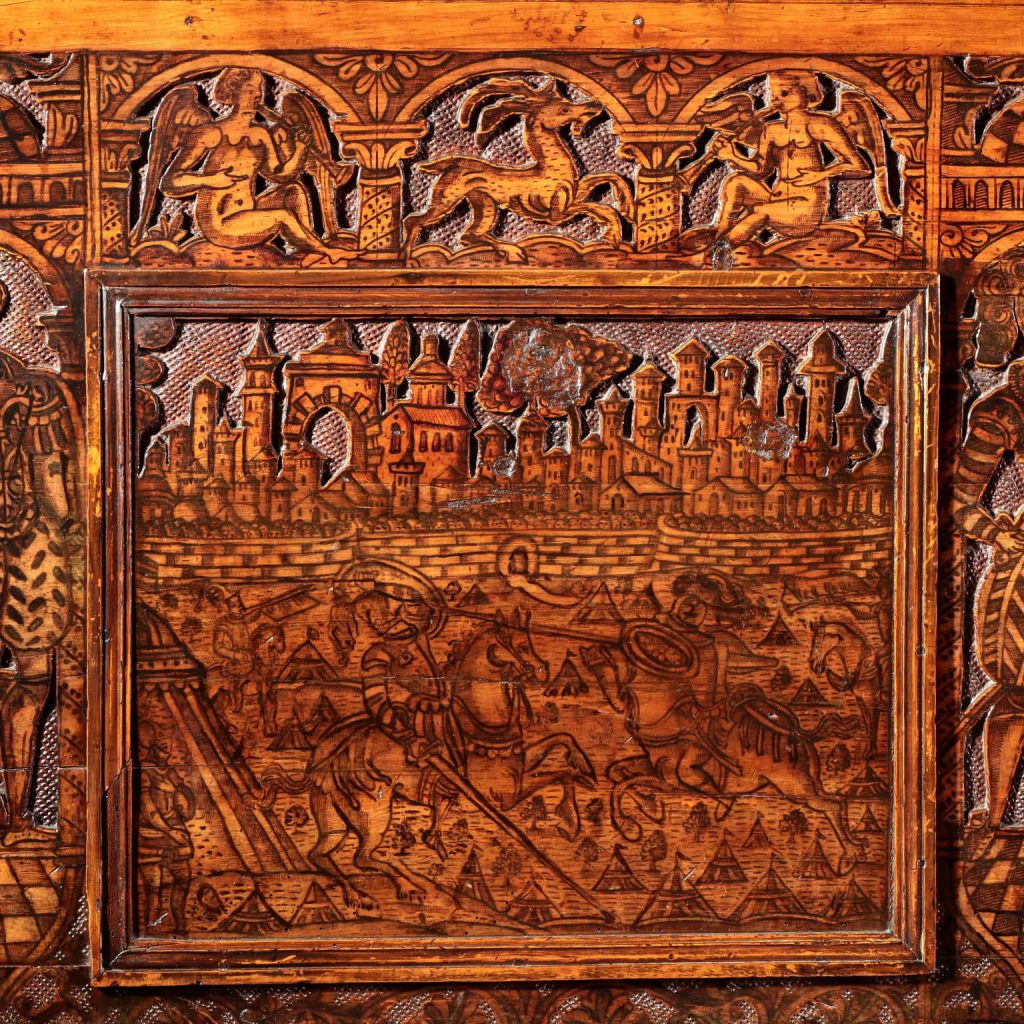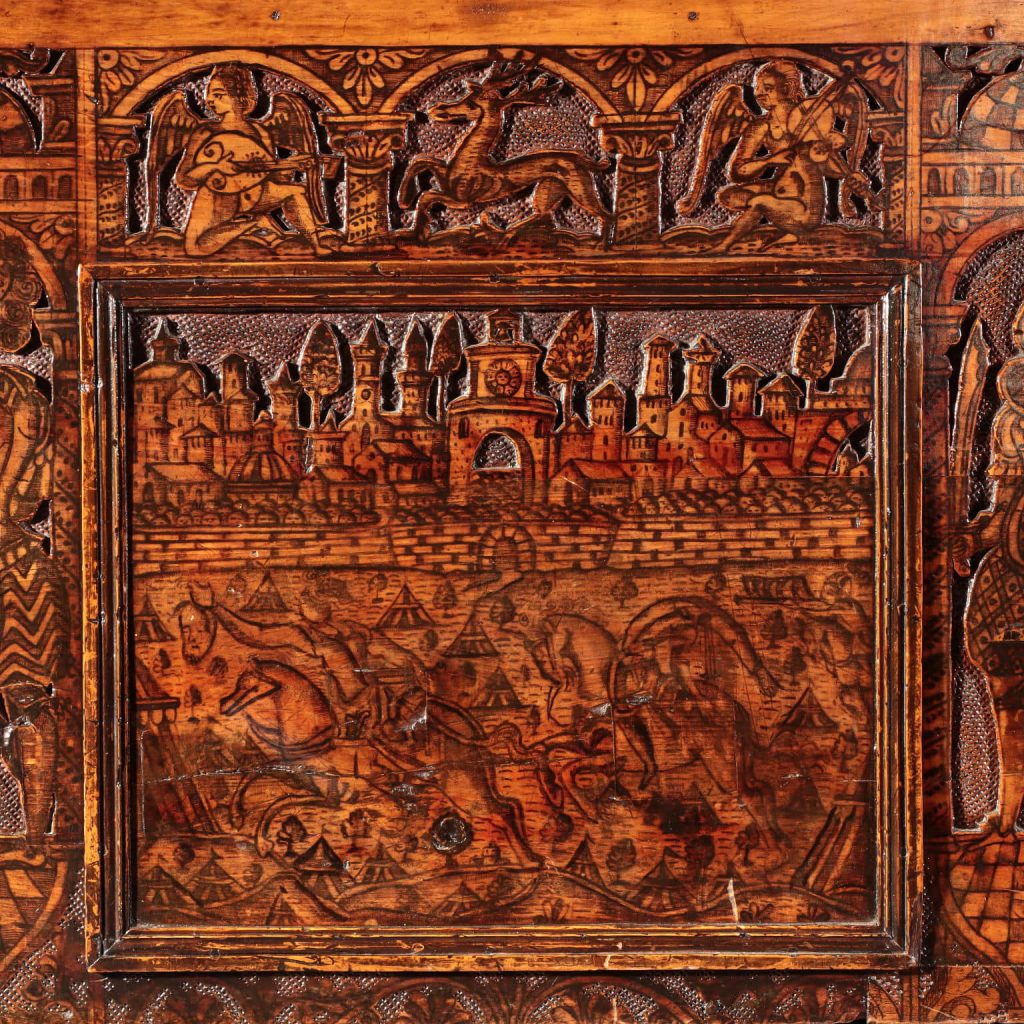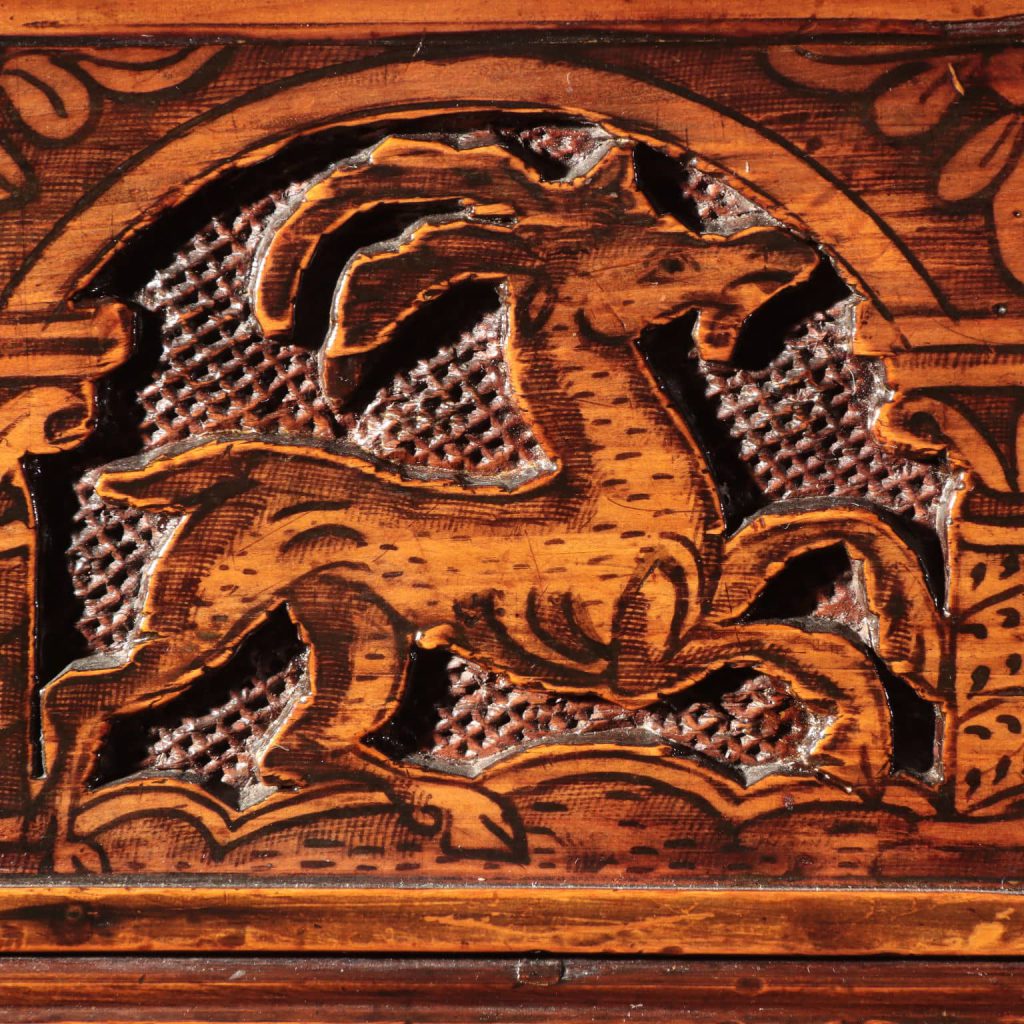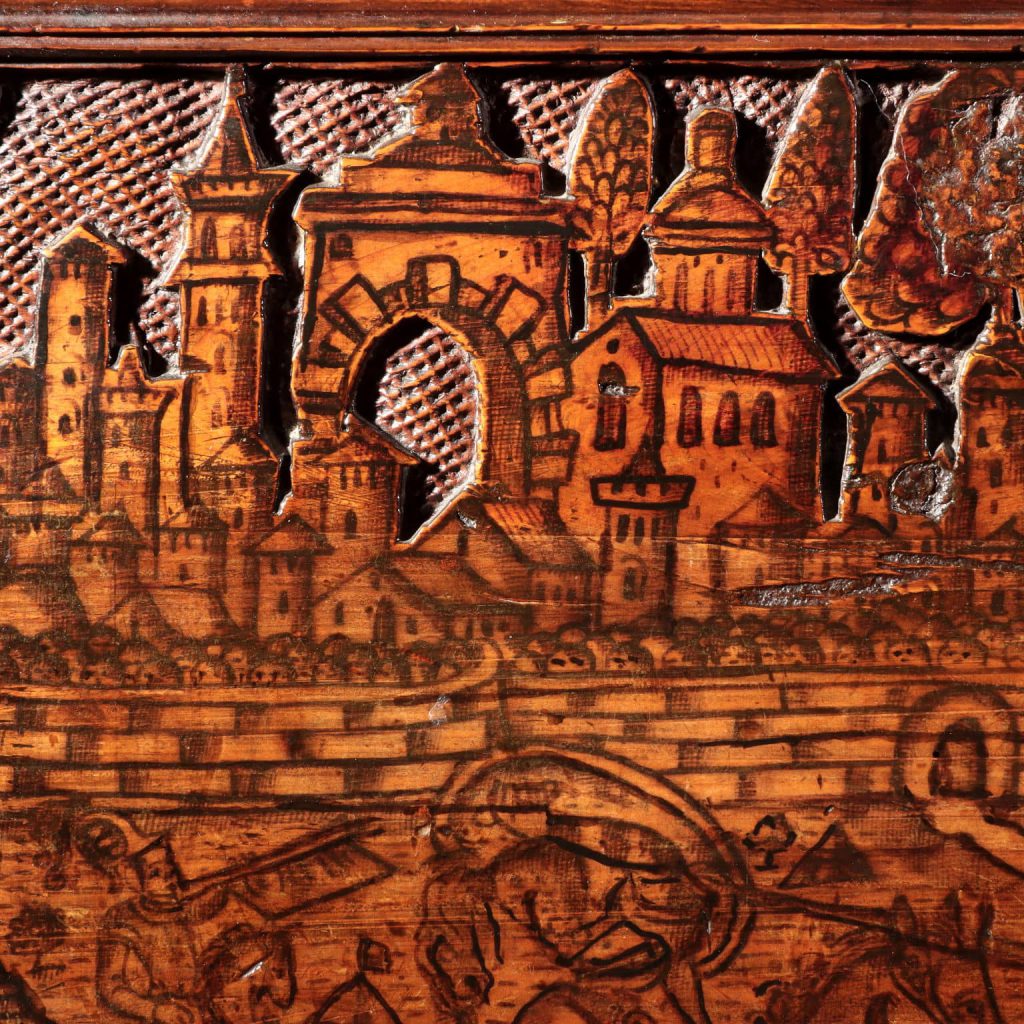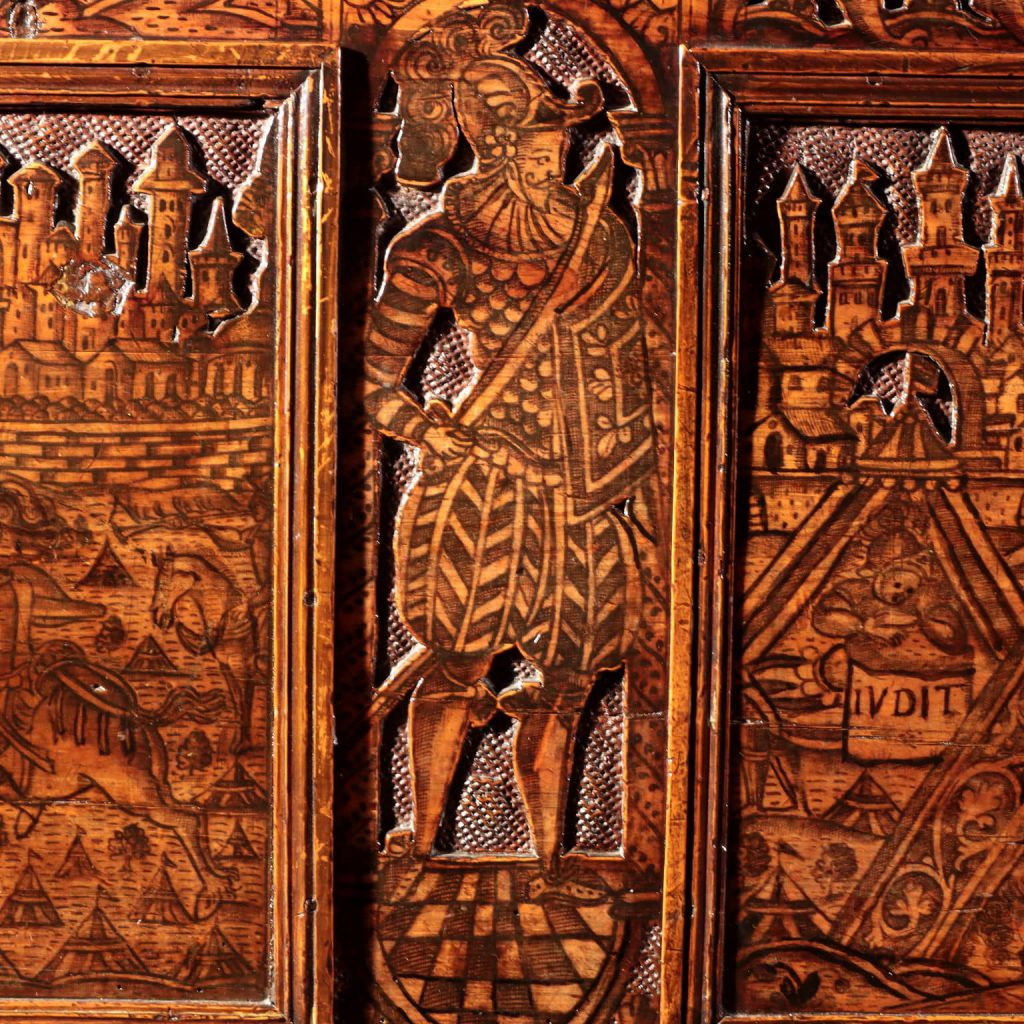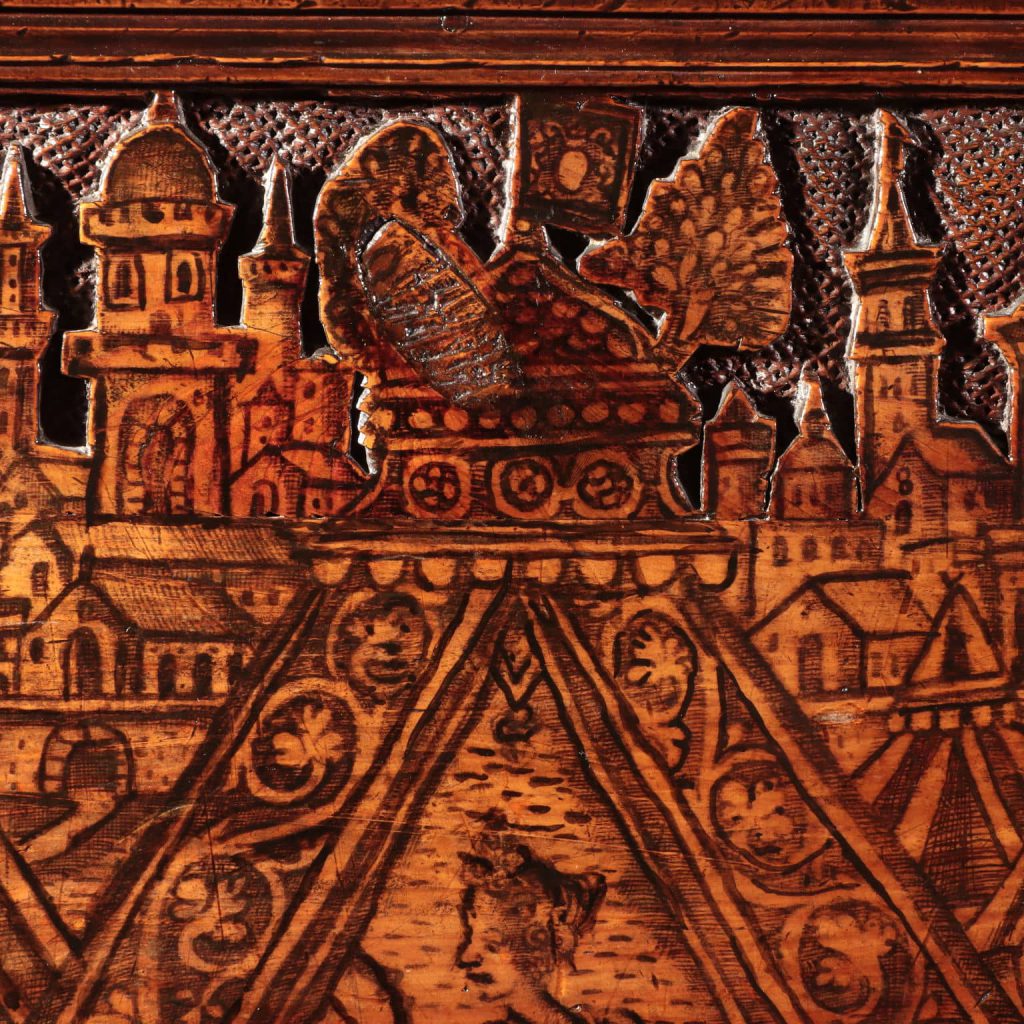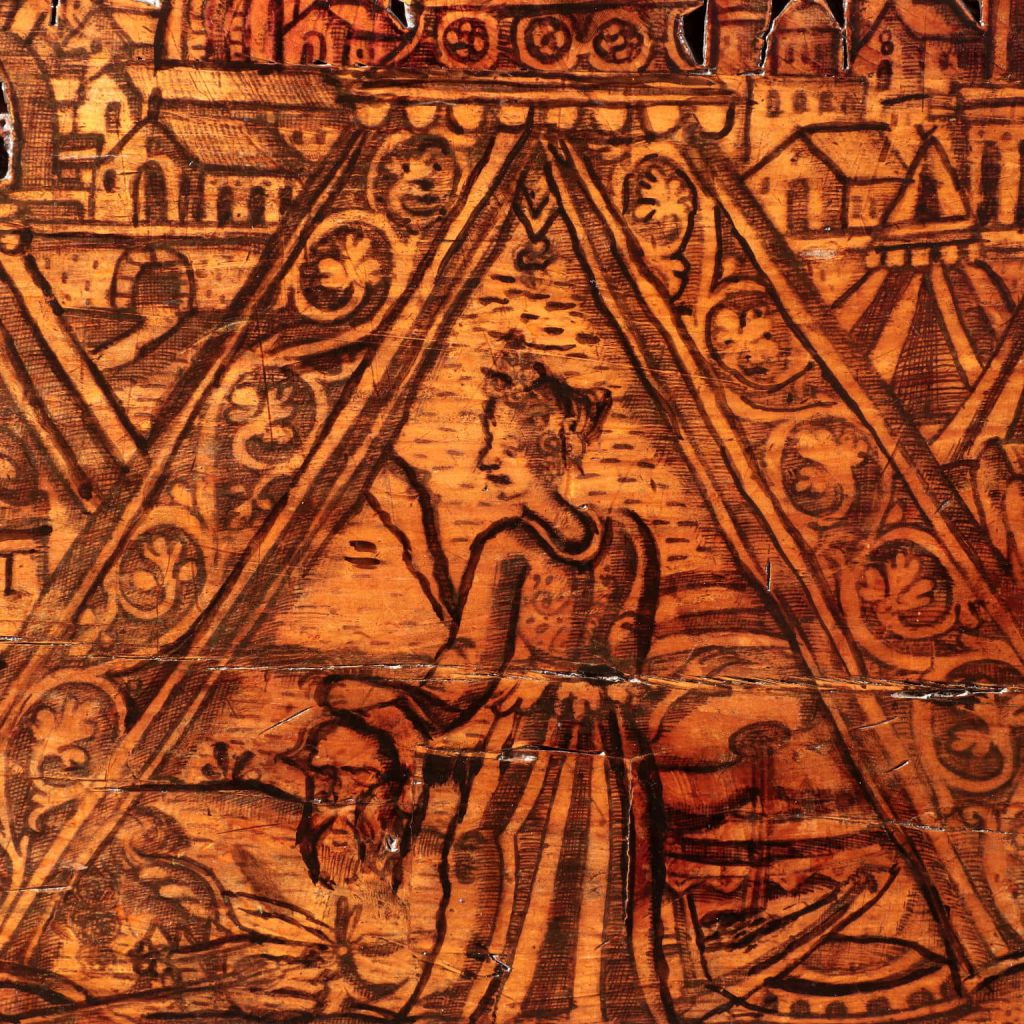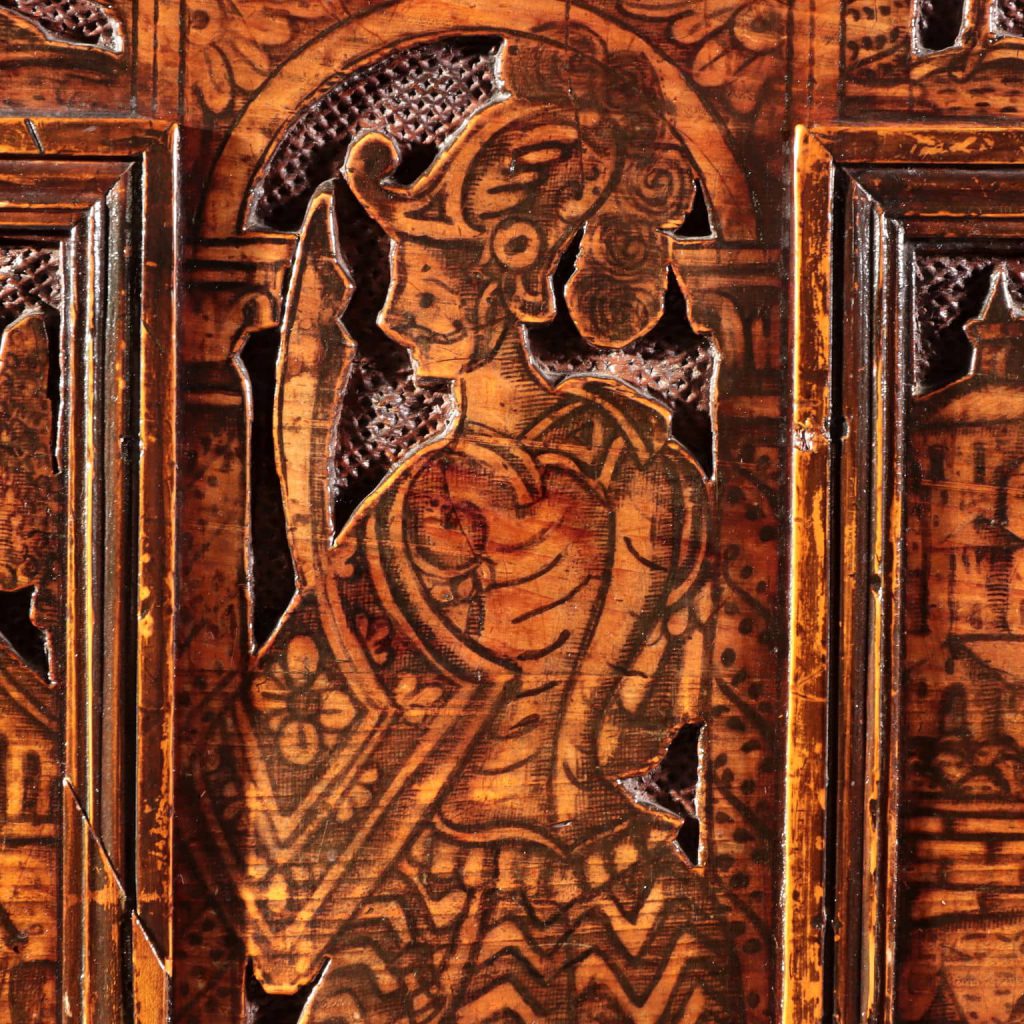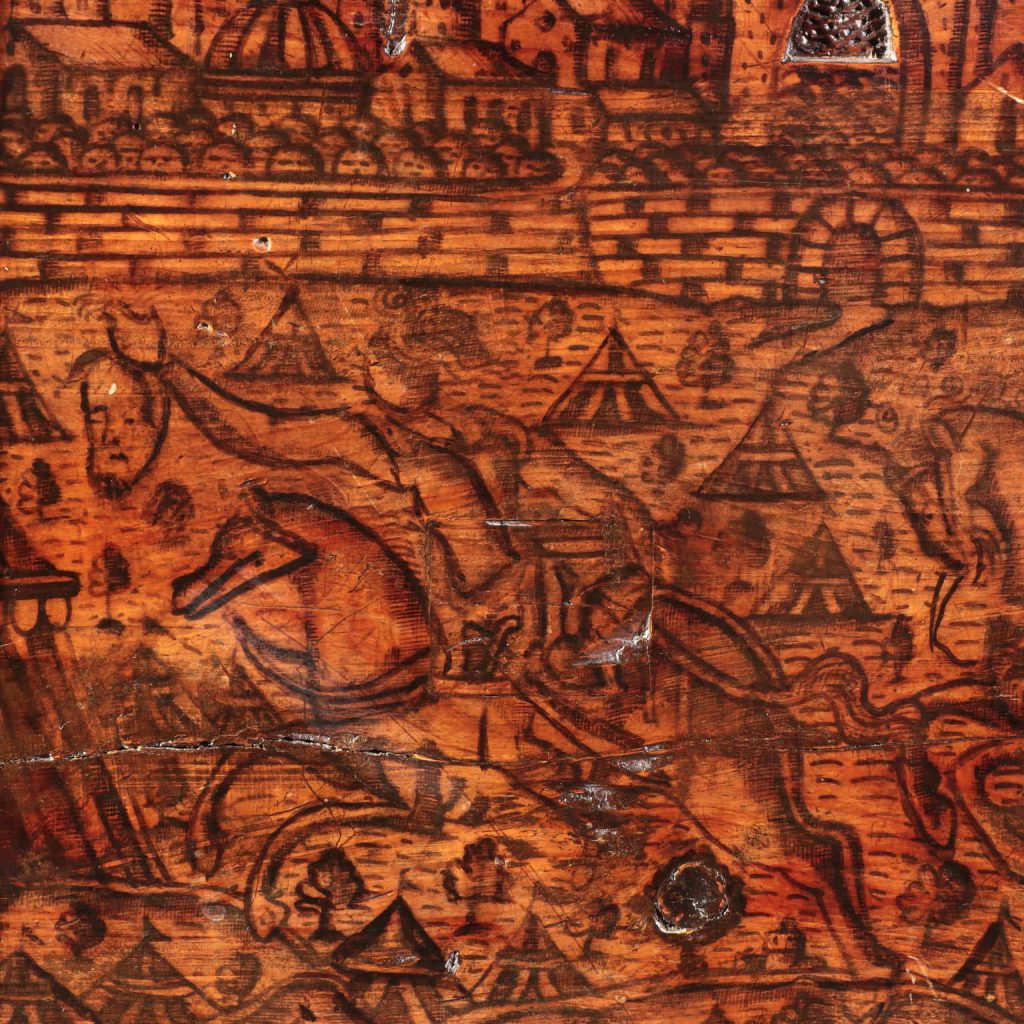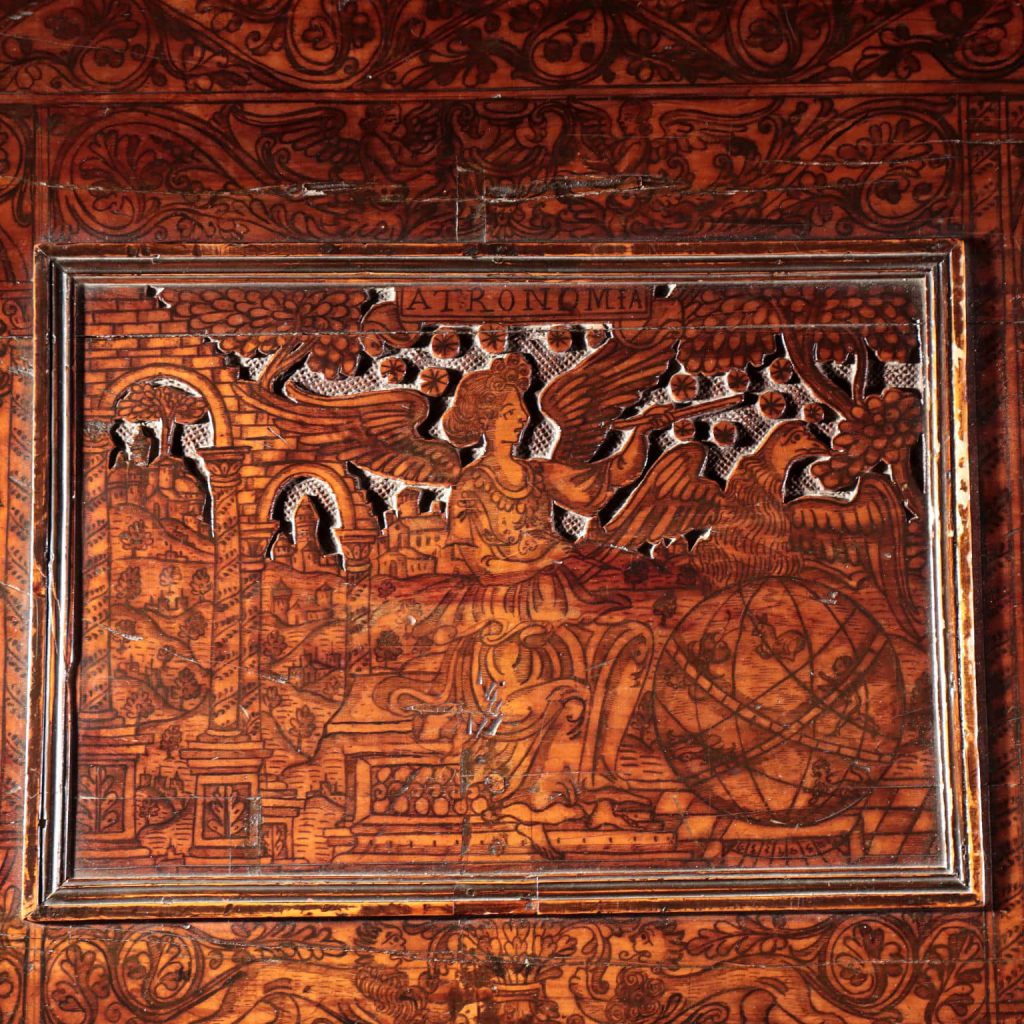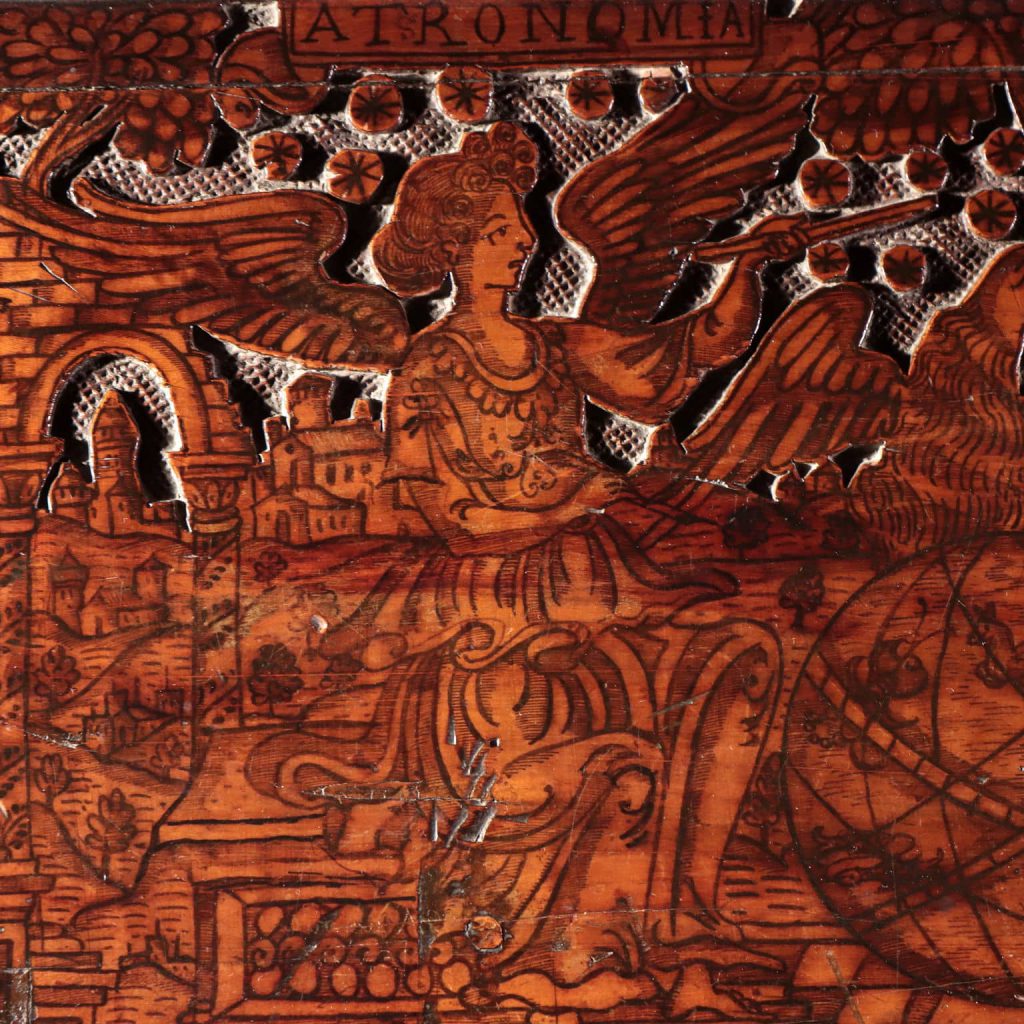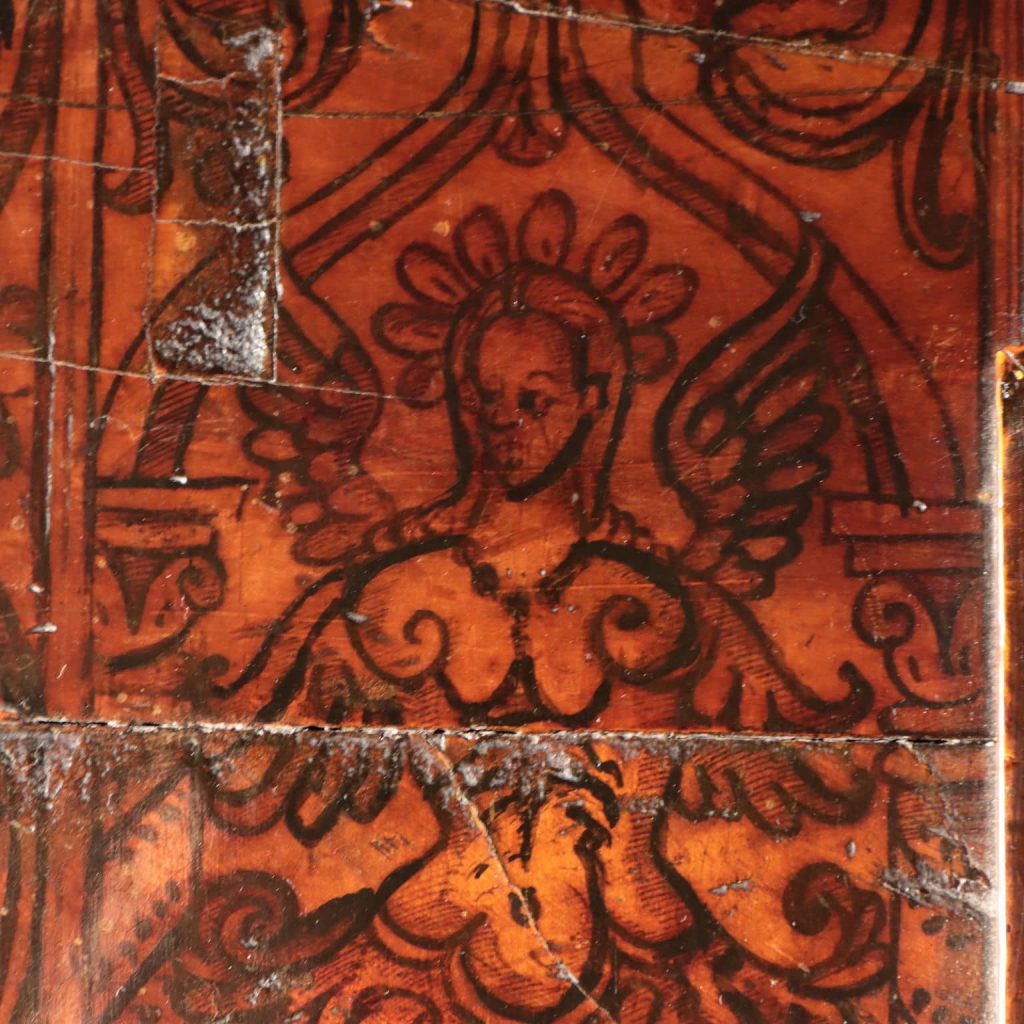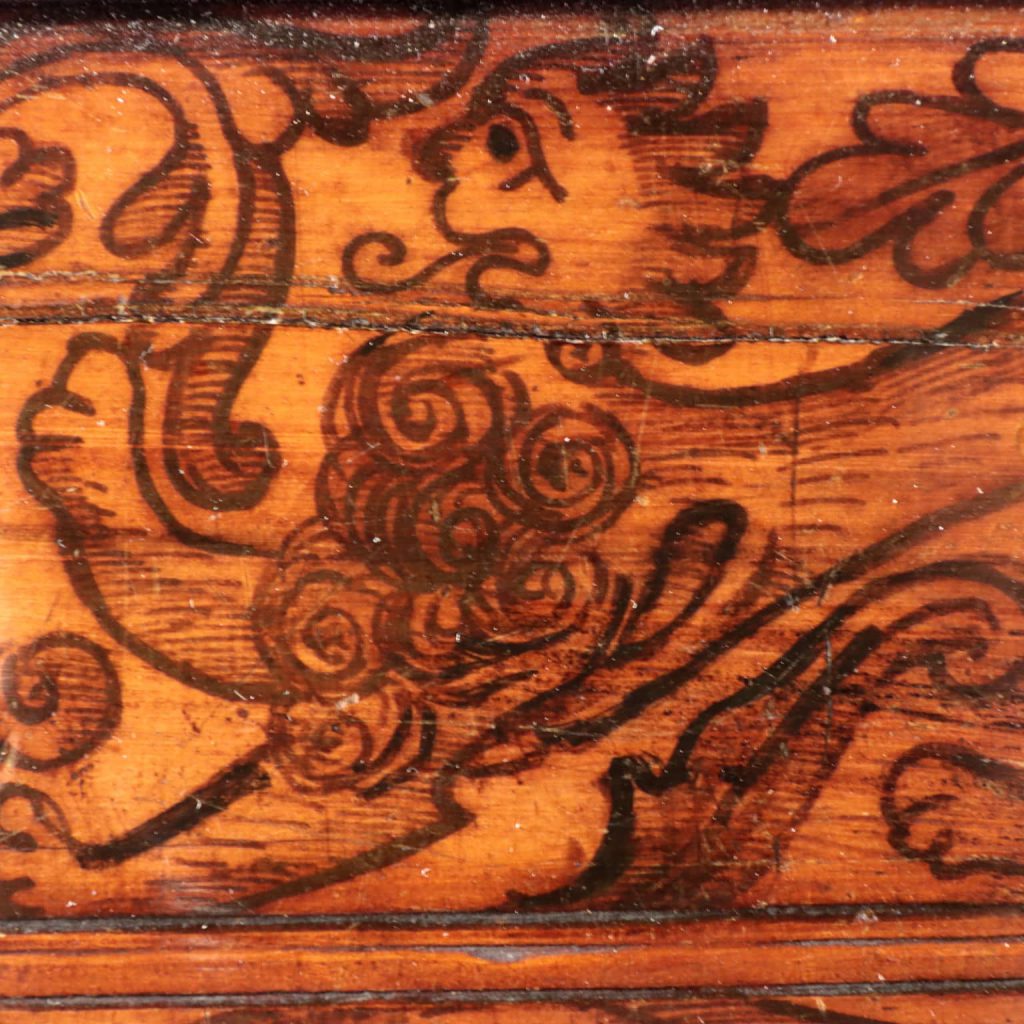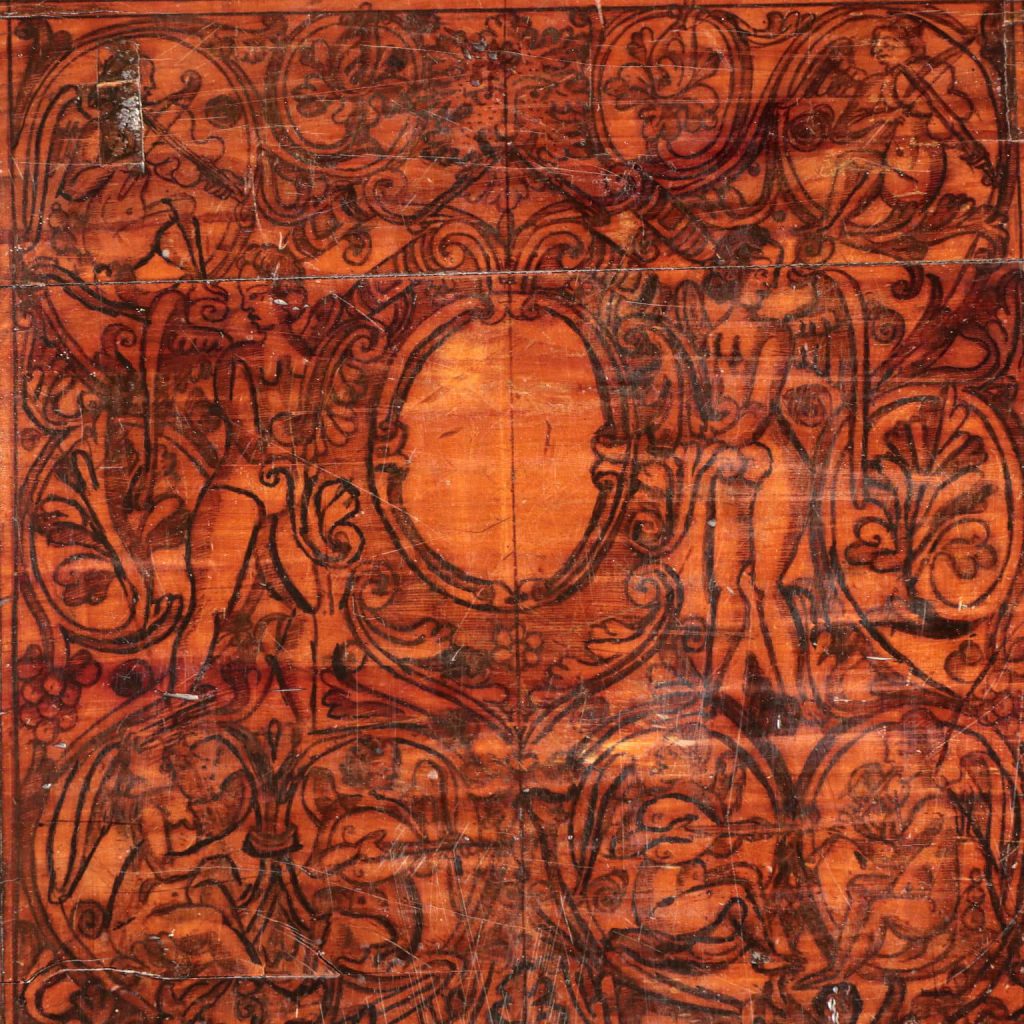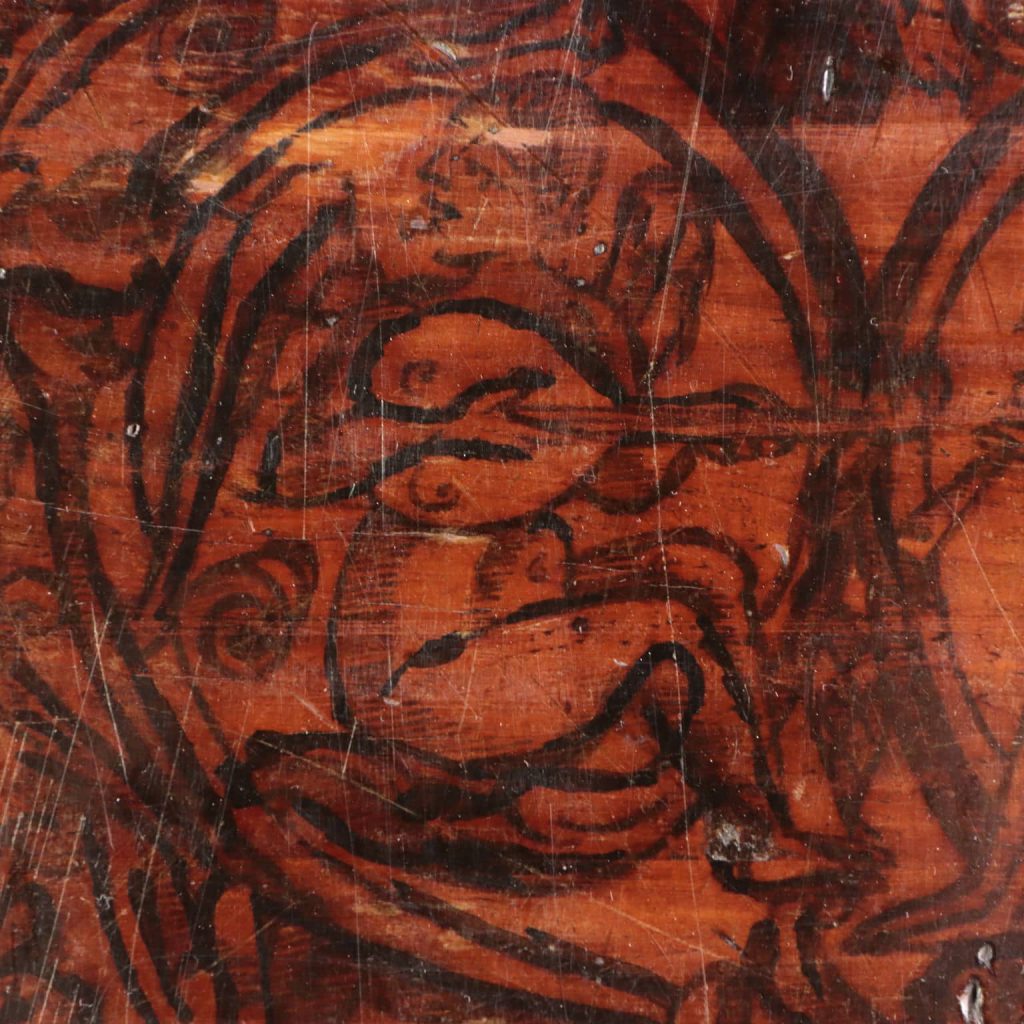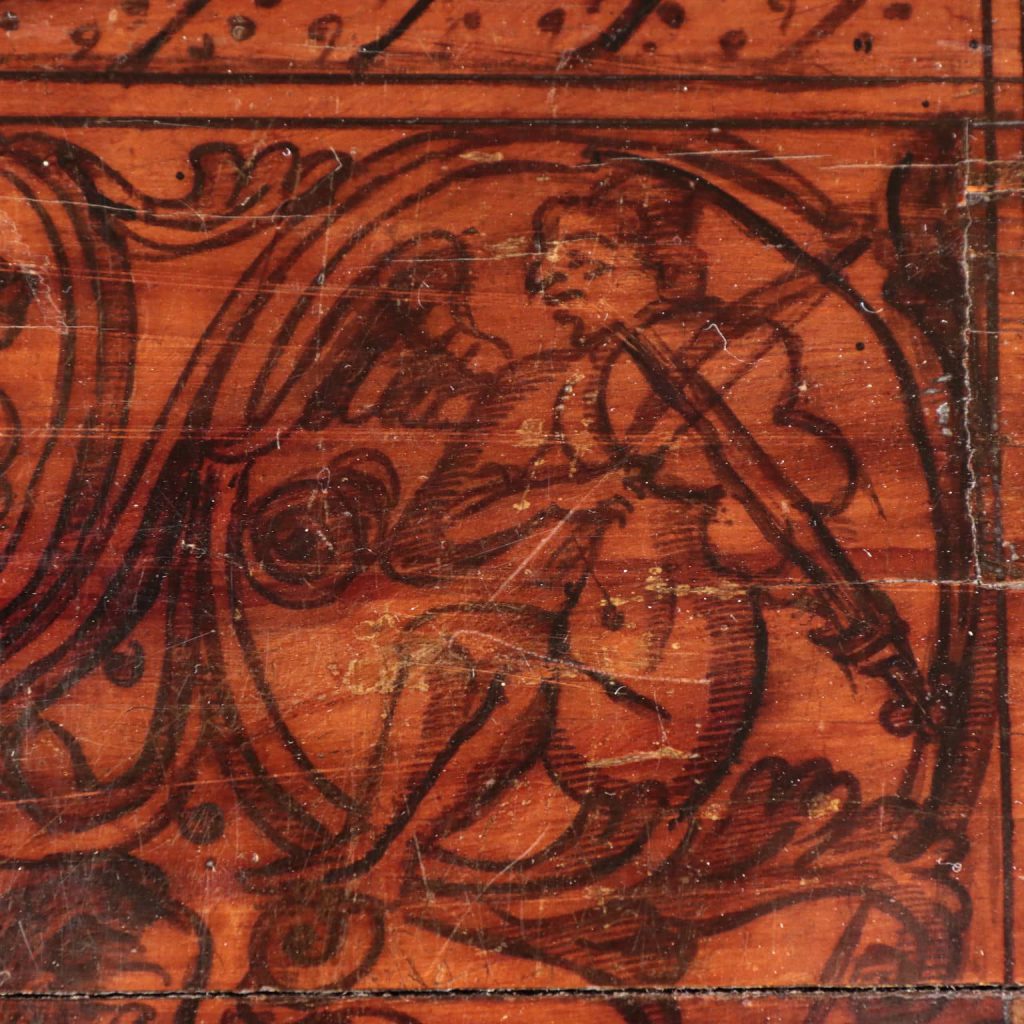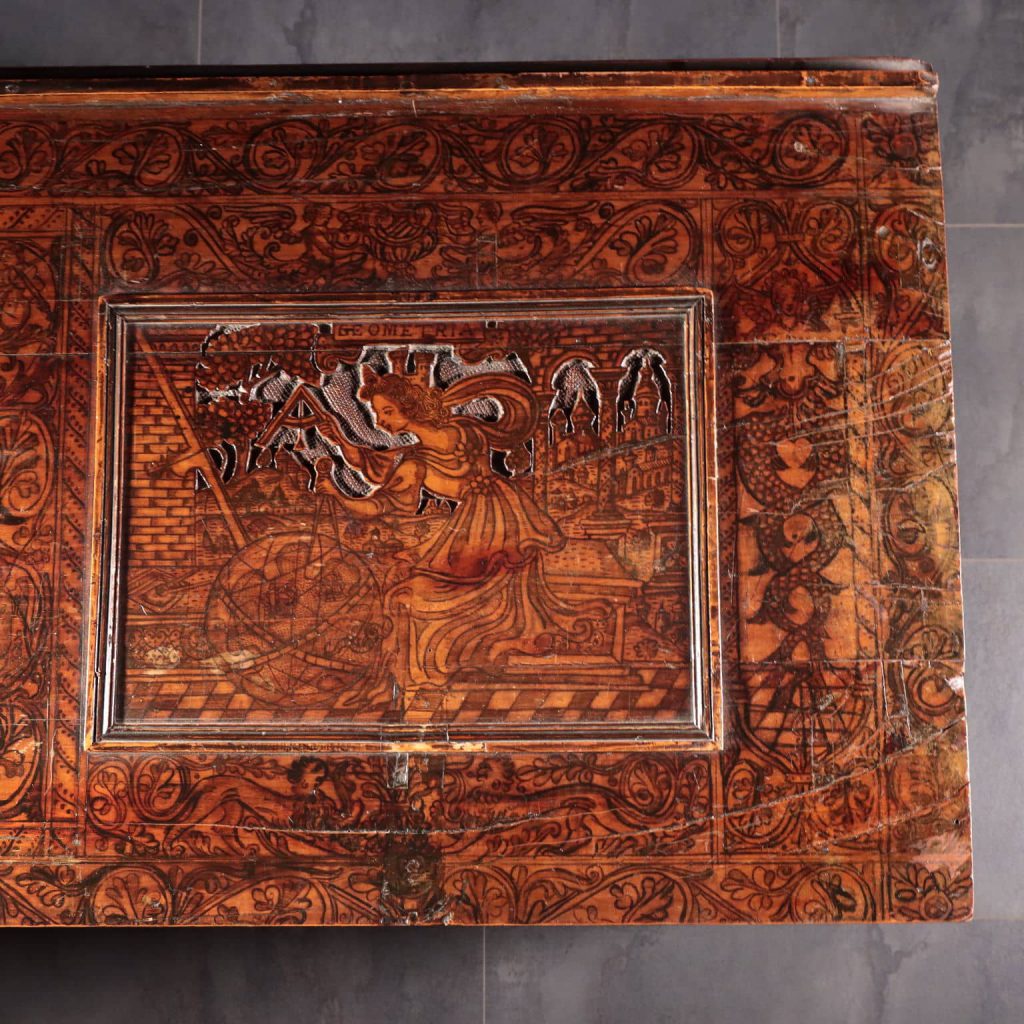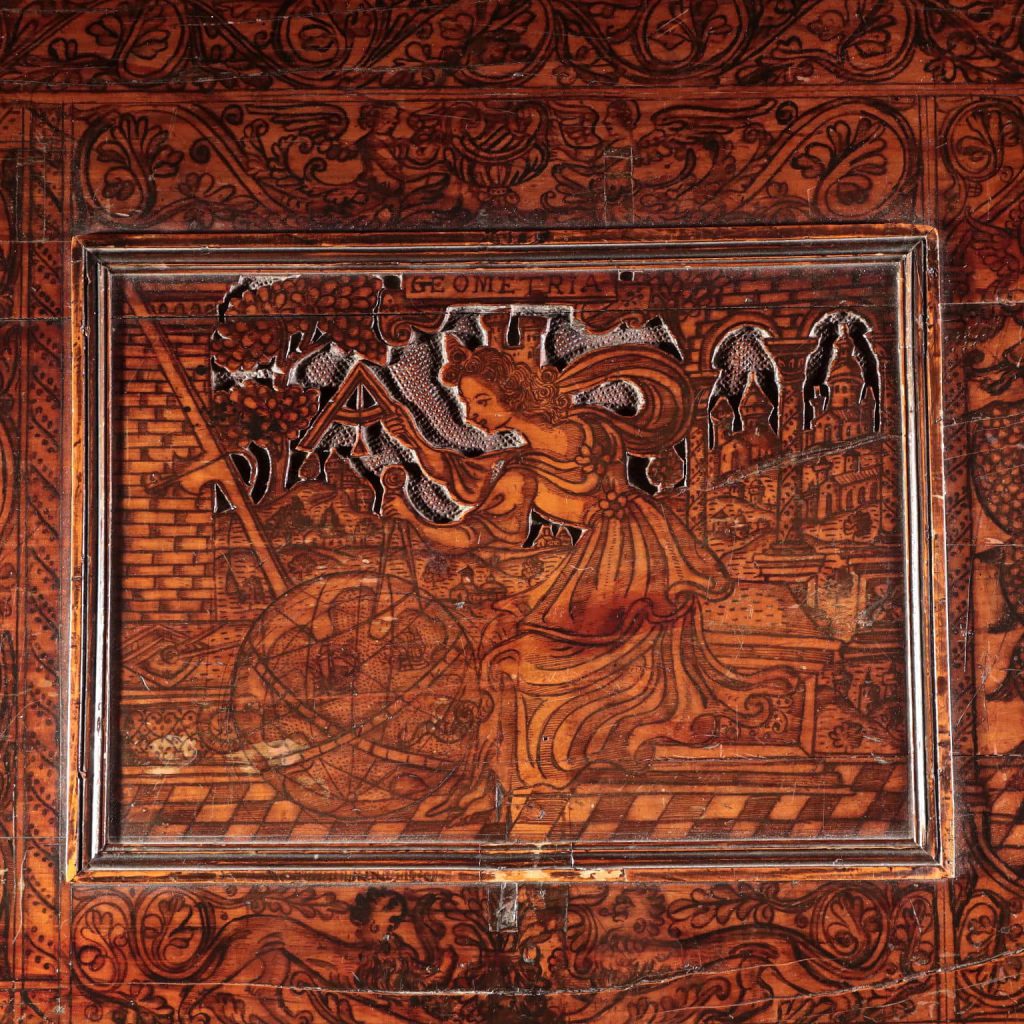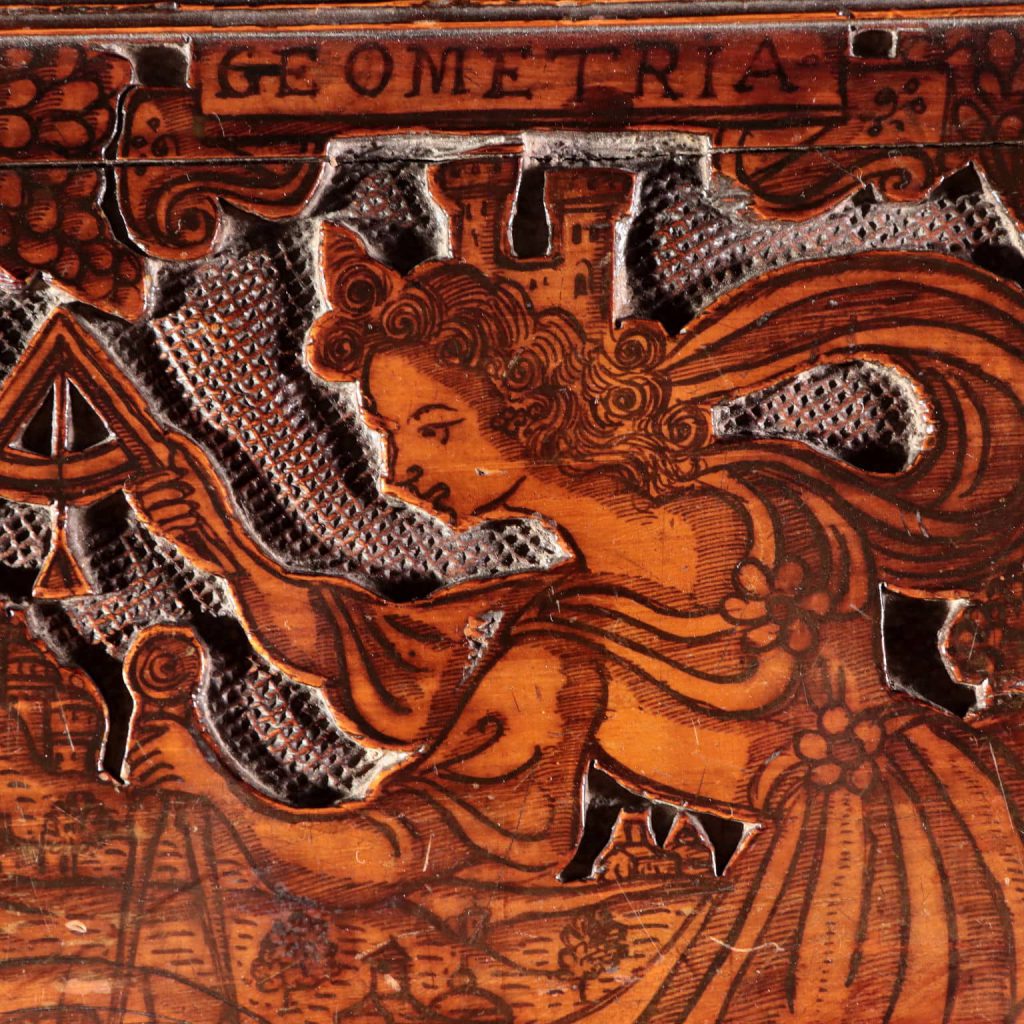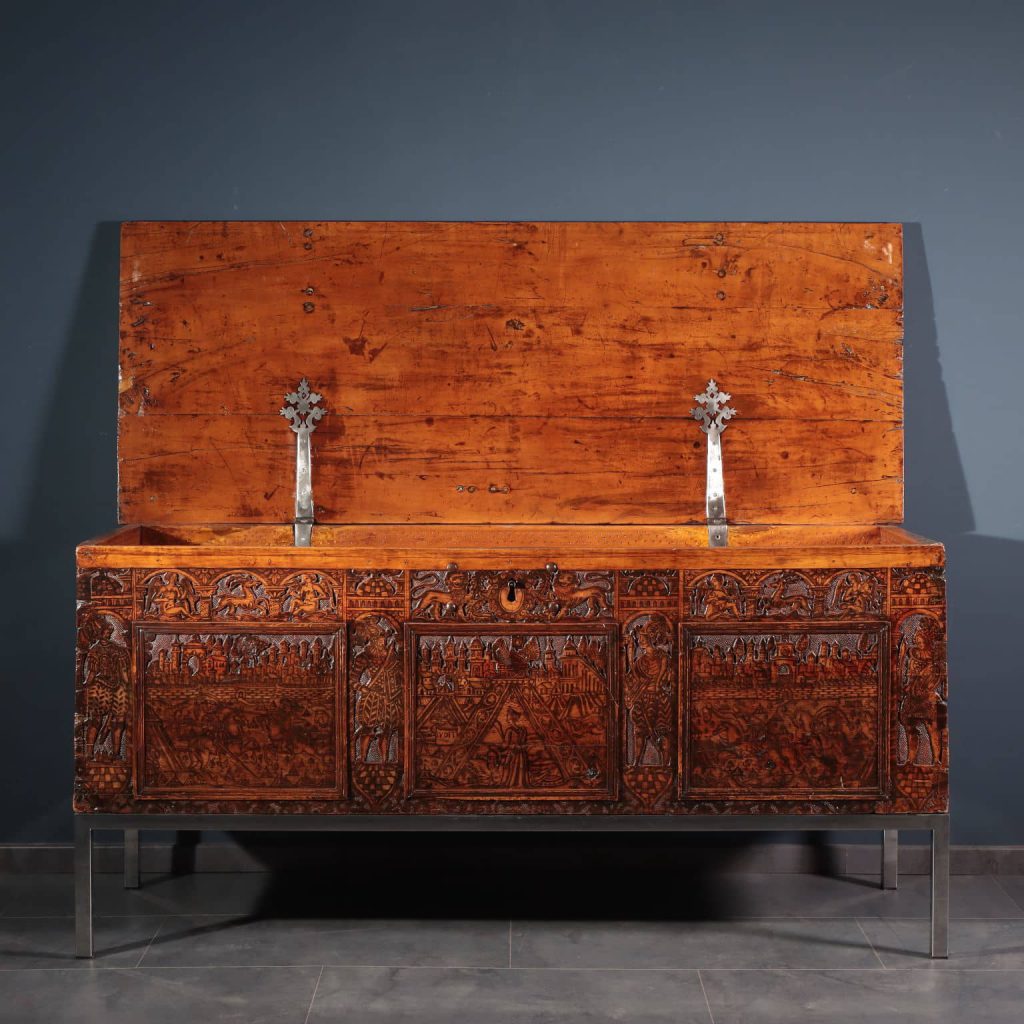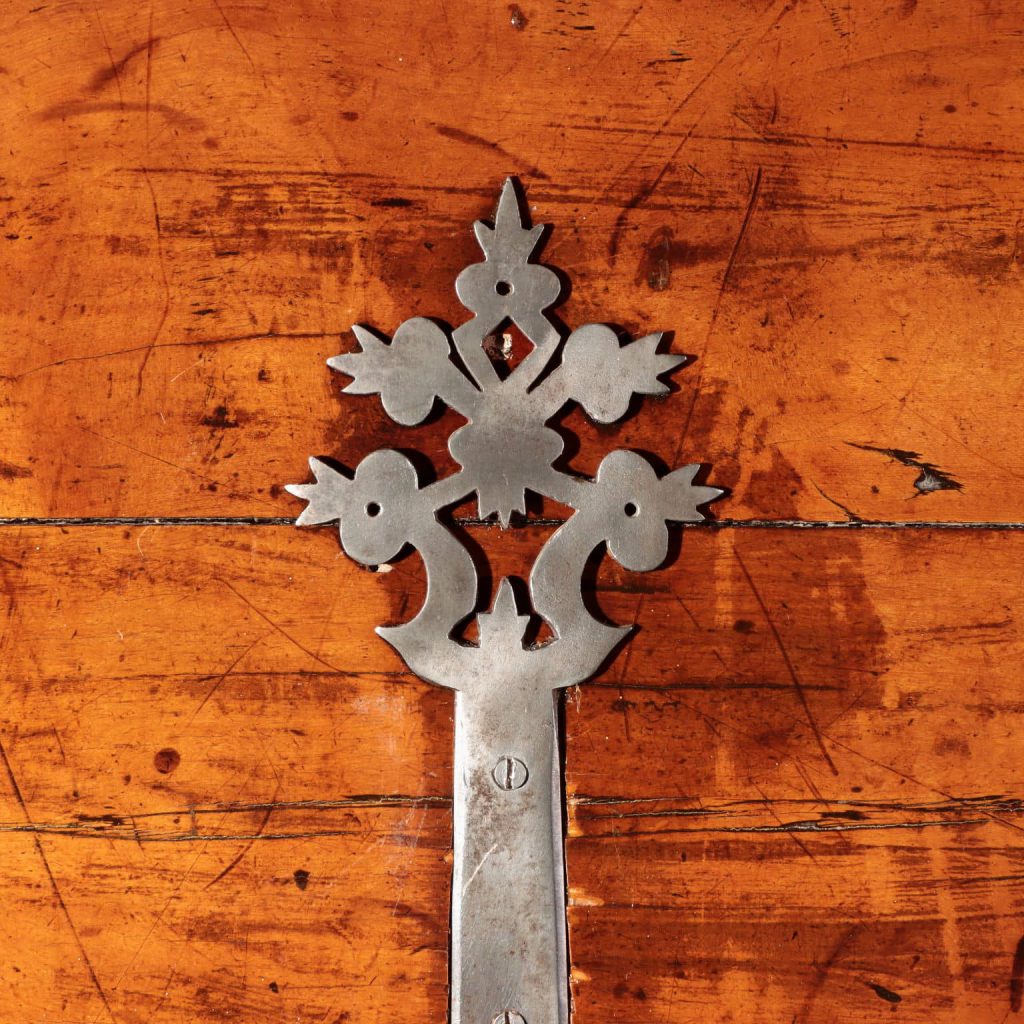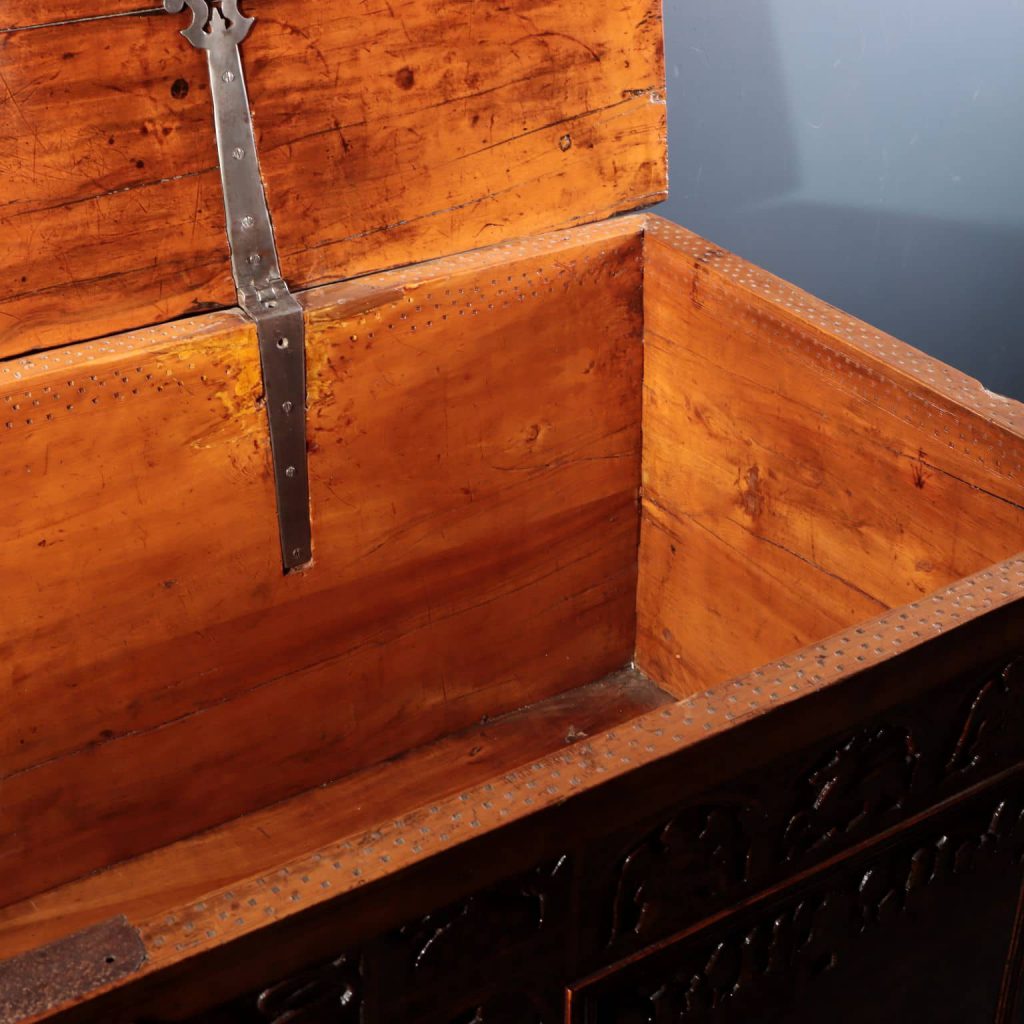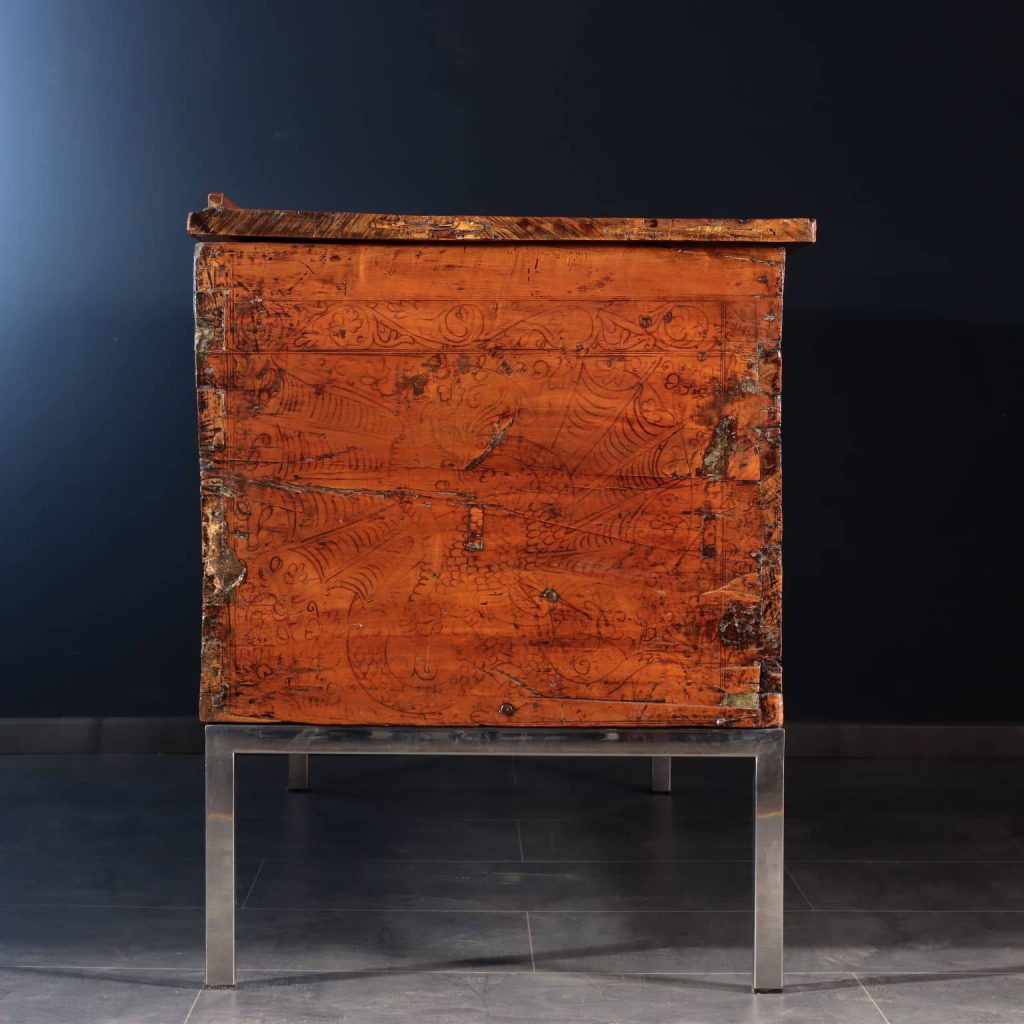Pyrographed chest, Veneto, Late 16th century
Veneto
Late 16th century
Description:
The front and the lid are pyrographed and cut out of a lowered and engraved bottom.
The lid is fixed to the body by steel iron hinges and worked with an elaborate floral motif, they have been relocated, so as to mount the lid in reverse, placing the machined face on the outside.
The lid has a dense horror vacui grotesque decoration, characterized by a perimeter band decorated with phytomorphic spirals and leaf motifs, also repeated in the innermost band, together with real animals such as lions and mythological ones, such as mermaids.
In the central perimeter band, grotesque motifs are always depicted, with cherubs intent on playing musical instruments, while two of them hold up an empty field coat of arms. Also on the lid there are two reserves delimited by carved frames, depicting two allegories made in champlevé. One depicts the “ASTRONOMY”, as specified by the cartouche above, depicted as a draped winged figure holding a wand, facing the starry sky.
In front of her there is a celestial globe surmounted by an eagle, while behind her there are ancient ruins and a hilly landscape with houses. The other reserve depicts the “GEOMETRY”, a turreted woman holding a compass and a perpendicular in her hands, with which she is intent on taking measurements on a terrestrial globe, where there are two vessels, and around which she is standing enveloping a snake.
It is represented inside a room bordered by a portico and furnished with chests, on which there are other scientific instruments. Beyond the loggia you can see a landscape similar to that presented in the reserve previously described.
The front is entirely made with the technique of the lowered and engraved bottom, marked by four vertical bands in which there are warriors in Renaissance clothes.
Among these there are three reserves, in the central one are represented Judith and Holofernes (“IVUDIT” and “OLOFERNI”), inside the tent of the Assyrian general, the Jewish heroine holding the severed head of the enemy, in the background the besieged city of Betulia. In the two sides there are instead scenes of fighting between knights, in the background the same city of the reserve in the center, therefore plausibly always referable to the siege of the Jewish city. The upper band maintains the tripartition: on the sides there are two putti placed on the sides of an ungulate, while in the central section two lions facing each other and placed on the sides of a coat of arms that houses the mouth.
Traces of the ancient pyrographed decoration can also be found on the inside of the lid (originally placed on the outside) and on the sides; on the latter you can glimpse a band adorned with phytomorphic spirals and two dragons. The stop is also decorated with burin geometric motifs, as is the band that runs along the entire internal perimeter.
Dimensions: 55 x 166,5 x 64,5 cm ( 21,6 x 65,5 x 25,4 in)
CODE: ANMOAL0104961
Historical-critical analysis:
The cassone belongs to those already active productions, with more archaic forms and constructions, from the mid-fifteenth century, as evidenced by some examples known to studies, easily datable thanks to the dresses and hairstyles of the ladies. In our case, the iconographic material and the knights’ armor allow us to date the furniture to the end of the 16th century. These are boxes and caissons of varying dimensions, with a process defined as “lowered bottom”, that is characterized by a decorative champlevé technique, a low relief on a bottom engraved by means of a small punch. Studies and traces found on some specimens suggest that all these backgrounds were originally filled with colored mastics, usually beeswax pigmented in green or red.
A similar example is kept at the Museum of Applied Arts of the Castello Sforzesco in Milan (inv. No. 13): a similar division of the front is found and inside the lid a tournament scene and still Judith and Holofernes are depicted. .
In particular, this object was quite widespread at the time, frequently used to decorate chests and wedding chests, commissioned on the occasion of important weddings. In our example, the figures represented on the lid are very interesting, a very cultured iconographic choice and therefore certainly destined for an erudite client.
The two allegorical figures refer to the indications provided by Cesare Ripa in his Iconology, but for geometry we find an interesting comparison with an invention by Martin de Vos (1531-1603), later also taken up by artists such as Johann Sadeler (1550- 1600). The Flemish artist also takes up the iconography proposed by Ripa, but re-proposing it in a personal way and with attributes that are also found in the allegory presented on our chest.
In particular, the choice of representing the figure with a turreted crown on his head, the accompanying scientific instruments and the foresight of depicting a snake wrapping itself around the globe, where, in both cases, vessels are found. It can therefore be assumed that our workshop was inspired by this engraving or that both of them were instead based on a single prototype.
Bibliography:
– Museo d’Arti Applicate. Mobili e intagli lignei, Electa, Milano, 1996;
– Clara Santini, Mille mobili veneti. L’arredo domestico in Veneto dal sec. XV al sec. XIX. Le provincie di Vicenza, Treviso e Belluno, Artioli editore, Modena, 1999.
- Pyrographed chest, Veneto, Late 16th century

Antiques, Art and Design
FineArt is the new ambitious Di Mano in Mano project that offers an exclusive choice of antiques and design works, presenting them for their singularity and uniqueness.

